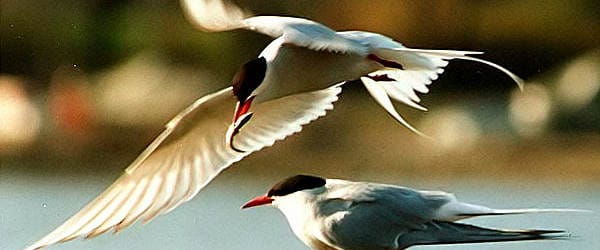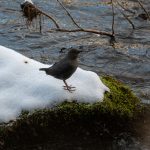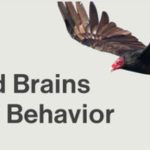To a birder, migration means that you can live in Minnesota, New York, Paris or Moscow and see exotic tropical birds such as Piranga olivacea and Icterus galbula on a regular basis without buying a plane ticket. The birds do the flying for you. Even if you don’t live in the summer range of a particular species, you may have opportunities to observe it while it passes through, especailly if you live in an active flyway, like I happen to. All of this leads to a longer life list, which is, after all, the entire point of bridwatching, right?
Well, you know I’m only joking about the life list. Birders are not, after all, stamp collectors. (Angry email from stamp collectors in 3 … 2 … 1 …) We are interested in conservation, ecology, biology, evolution, and all sorts of other aspects of Aves. Since many birds migrate and many of the things that migrate are birds, migration is bird-salient.
But what is migration, why do birds do it, and how is it accomplished? Way back when I started what turned out to be my thesis research (on humans), it became important for me to learn about bird migration. I was involved in the study of human movement and navigation on land, and there was a lot of research coming out about bird navigation. Some of the first solid research pointing to a magnetic sense of some sort in birds was being produced at that time, and there were even people testing humans for a similar ability. Some of the research being done then (the 1980s) was pretty naive and sometimes downright silly. One scientist was attaching magnets to the heads of British school children, whom he would then drive, blindfolded, out into the countryside where they would be released. The idea was to see if those without magnets taped to their heads got less lost then those with the magnets. People were doing things like that with birds, sharks, and humans.

Itcher birds, migratory members of the tern family. Specifically, Itcher Tern. Image source.
You’ve probably already noticed that I started out on the topic of migration (seasonal movement, often over long distances) and quickly switched to navigation (finding one’s way). That’s because the two are related. Migration is a larger scale integrative behavior, and navigation is one mechanism that may be involved in migration. And, much of the research being done in those days was about the mechanisms. Since I was mapping-in human ‘territories’ or home ranges, and trying to figure out how tropical hunter-gatherers found their way around the landscape, the mechanisms of migration were interesting to me. (It turns out that humans without compasses make no use of magnetic fields.)
Eventually, it would be determined that birds have at least one way, and probably more than one way, to sense the earth’s magnetic field. They can use this form of sensory input to navigate, integrating this information with other data to determine and adjust migration routes as adults. In addition, there may be some built-in (genetic) processing ability. For instance, birds that never before navigated anywhere (because they were just hatched) seem able to know, from magnetic data, that it is necessary to stay around and feed up before a long ocean crossing1.
But I’m getting a bit ahead of myself. In one simple blog post, it is impossible to address even the most basic questions about bird migration. What I’d like to do, however, is to present one single question related to migration, which in turn will spawn (or, rather, hatch) myriad other questions ranging from trivially easy to impossible to answer.
The question is this: Did migration, as an adaptation used by birds to address seasonal variation, emerge once in bird evolutionary history, or is it a feature that has evolved again and again as needed? Or, to put it a different way, “Is there a ‘migratory syndrome’ common to all migrant birds?”2
This is not a simple question and it is not trivial. Consider the implications. If migration evolved many times in birds, then it would be worth asking if it evolved in birds more often than in other groups of vertebrates. The answer would surely be “yes” which then leads to the question of why? Did birds repeatedly evolve migration because they ‘need’ to migrate more than, say, mammals? Birds, because they fly, don’t store fat without paying a huge cost, which might in turn make them more vulnerable to variations in both food supply and thermal stress than ground dwelling animals. Did birds repeatedly evolve migration because they can? In other words, many sorts of animals might benefit from migration, but those with powered flight might be able to develop a migratory behavior more easily than those stuck to the ground on hooves. Those two questions are not mutually exclusive.
Another question this raises has to do with migration itself. Why migrate? In the words of the famous bird migration expert, Thomas Alerstam, birds migrate because the earth is tilted.3 The tilt of the earth on its axis of rotation, in relation to the orbital plane, causes seasonality. Seasonality causes variation in warmth, variation in moisture, and variation in food supply. There are a lot of ways to adapt to these variations, and one of them is to migrate.
Turning the question to a different direction, conceptually, we can ask how migration works. If migration is something that emerged once, such that all living migrant species of birds inherited this migratory adaptation ultimately from one original progenitor species, then all birds should use similar mechanisms for migration. Right? Well, not really. It is quite plausible that the primordial migratory species used a particular mechanism for navigation that was supplemented in different subsequent lineages by different additional mechanisms. Indeed, given the great length of time over which Aves has existed in its more or less modern form, it is quite possible that the original primordial mechanism of finding one’s way, or the mechanism for knowing when it is time to leave, or other migration-related tools of the trade, were lost in some but not all lineages. And then re-emerged later in some cases. And so on. In other words, the great time depth of bird evolution coupled with the astounding diversity of birds would seriously muck up any simplistic pattern of evolution over time.
One way to organize these ponderous complexities is to refer to our Tinbergen. Niko Tinbergen is famous for proposing a particular way to ask questions about biology. He defined four modes of question: Ultimate, Phylogenetic, Mechanistic, and Developmental. Lets try the question of migration in this context:
Ultimate: Why do birds migrate? They migrate because those with migratory adaptations who moved from region to region to follow seasonal changes in food supply or other resources had, ultimately, higher Darwinian fitness.
Phylogenetic Why does, say, the Scarlet Tanager migrate? Because the ancestor of this species of bird migrated, and the migratory adaptation and all that entails were passed on. This Phylogenetic explanation is trivial unless viewed as a imitating or potentiating effect; A living population of Tanegers already has, say, a tendency to feed up as day length shortens (I assume for the purpose of argument). Therefore, this adaptive feature is available in these individuals to be exploited by some other adaptation such as the tendency to turn off productions of hormones that would cause nurturing behavior. And so on.
Mechanistic: How (not why) does a particular bird migrate? This is certainly, for the present topic, the most complex of the tTinbergian questions, though for some other adaptation it might be trivial. The “how” part of the migration question is huge, multi-faceted, complex, often mysterious, and awesome. I mean, seriously. Some birds, it would seem, can actually see the magnetic field of the earth. In a sense. Literally. Holy crap.
Ontogenetic: How does the capacity of migration emerge in an individual bird, developmentally? This actually turns out to be a question nearly as complex as that of the “how” question. Do newly hatched birds learn a migration route by following experienced birds? Will uninitiated birds attempt migration in the absence of adults, and if so, will they be any good at it? How do we compare bird species where the young fly off with adults vs. those where the young stay behind a few more weeks (like the Common Loon does) and thus never have the chance to learn a route or destination? And, for those birds that rely on magnetic fields, how does a bird deal with secular changes (small changes over decades) in the earth’s magnetic field, and how does a bird deal with the very rare event of a total reversal in the field’s orientation? Holy crap again!
Now, consider the alternative answer to the original question: No. Bird migratory behavior evolved many times, among different lineages of birds. If that turns out to be the answer to the question of how often the migratory adaptation emerged, we’d have a very different and probably more complex history of birds to deal with. It is quite possible that flight emerged in birds, and that migration emerged in different lineages at different times and in different places, and possibly for somewhat different reasons. If this is true, then does each separate evolutionary “event” have a separate set of mechanisms backing it up? Do some birds migrate with magnetics, others not? Do some birds make mental maps of the landscape as newly minted birds following the flock with elders, while others just fly south until they hit the edge of a continent? If there is diversity in mechanisms (as suggested above) for a single-evolutionary event model, there would certainly be that diversity times ten (or some other number) if migration emerged multiple times.
![]() Piersma et al do in fact address this question, though they don’t settle it:
Piersma et al do in fact address this question, though they don’t settle it:
Bird migration has been assumed, mostly implicitly, to represent a distinct class of animal behavior… Here the evidence for the existence of what could be called a “migratory syndrome,” a tightly integrated, old group of adaptive traits that enables birds to commit themselves to highly organized seasonal migrations, is assessed.
The authors examine migration related traits and address the theoretical problems of massive comparisons across large numbers of physical features and behaviors across many species. They conclude, provisionally,
… that, perhaps apart from a capacity for night-time compass orientation, there is little evidence for deeply rooted coadapted trait complexes that could make up such a migratory syndrome, is suggested.
In other words, they suggest that bird migration did not evolve once, and/or is not a single unary thing. They suggest that more study of genetics and physiology may lead to a more detailed description of how migration evolved.
I want to return briefly to the premise and note some caveats. The answer to the question “did bird migration evolve once” can be yes even if it evolved more than once. If most migratory birds migrate because their ancestors did, and that goes way back to some primordial bird, but one or two groups of birds independently came up with migration later (from an ancestrally non-migrating stock) then the answer would still be, effectively, “yes.” Well, technically, it would be a no. But either yes or no would be qualified, and the “yes but with qualifications” would be more correct than the “no because we are pedants” answer. And more interesting.
Also, it is possible that migration evolved more than once in birds, but only once in living birds. If migration is such a good idea, and birds’ ability to fly is a big part of that, then one might well expect migration to emerge again and again once flight got well established as an adaptation. But, anything that emerges in several lineages early in the diversification of a clade of critters could easily be represented today by only one original lineages, the other lineages having died out. That is more than a little bit possible given the time depth of Aves.
Another question has to do with the nature of flight in relation to migration. Lots of birds do not fly at all, or don’t fly very much. Most of them don’t migrate. A fascinating exception to this, of course, are penguins. They don’t fly, but they migrate. But generally, flightless birds don’t migrate. But among birds that do fly, there is a poor correspondence between how efficient birds are at flight and whether or not they migrate or how far they go. Some of the most spectacular migrations in terms of distance, especially distance over water, are found among birds that are very efficient fliers, or that use wind and updrafts very effectively. So yes, there is some relationship between the power of flight and how it is implemented in a given species and migratory feats. And birds that only walk (i.e., have very poor flight abilities indeed) don’t migrate. But in the vast in between where most birds exist there are all sorts of contradictory examples. Little tiny birds with their little tiny wings and high daily energetic demands fly zillions of miles, while larger birds migrate shorter distances, for example. And then there is the loon. Loons hardly ever fly when they are on their breeding grounds or their winter-water, but the migration is for many loons a non-trivial distance. The same may well be true of navigation. Is it necessarily the case that the ability to navigate is correlated with the demands of migration? Well, no, definitely not. Take homing pigeons. Homing pigeons are very impressive navigators, but they don’t migrate. In fact, they don’t really “home,” in the wild. Homing pigeons are a domesticated form of rock dove that with very little artificial selection have amazingly impressive long-distance navigation skills, but that come from a root stock of non-navigating birds. Holy crap again!
Migration in birds is truly a touchstone to most aspects of bird ecology, behavior, evolution, and it is also a touchstone to bird conservation. For instance, much has been written recently about the effects of climate change on bird migration. Perhaps that will be the subject of a future post in this space.
______________
1Fransson, et al, 2001. Bird migration: Magnetic cues trigger extensive refuelling. Nature 424, 35-36:
Long stretches of sea and desert often interrupt the migration routes of small songbirds, whose fat reserves must be restored before these can be crossed as they provide no opportunity for refuelling. To investigate whether magnetic cues might enable inexperienced migratory birds to recognize a region where they need to replenish their body fat, we caught and held thrush nightingales (Luscinia luscinia) in Sweden just before their first migration and exposed them to a magnetic field simulating that at a migratory stopover in northern Egypt, before the Sahara Desert. We found that this magnetic field stimulated the birds to extend their fat-deposition period, indicating that magnetic cues may help small migratory birds to confront large ecological barriers.
2PIERSMA, T., PÉREZ-TRIS, J., MOURITSEN, H., BAUCHINGER, U., & BAIRLEIN, F. (2005). Is There a “Migratory Syndrome” Common to All Migrant Birds? Annals of the New York Academy of Sciences, 1046 (1), 282-293 DOI: 10.1196/annals.1343.026
3Alerstam, Thomas. 1982. Bird Migration. University of Cambridge













Holy crap! My head is spinning. Yes, or no? Once or many?
LOL Itcher Tern? Egad. Cute.
Nobody knows!
A fascinating read, thanks Greg. I was wondering if you could answer a related question on this topic. In Australia the middle of the country is usually a desert, but every few years enough rain falls across the East Coast to fill many lakes with water. When this happens many shore and wetland birds, including seasonal migratory birds, can be found at the lakes, which are hundreds of kilometres inland. The question is; how do the know to go there? Cheers 🙂
Jeremy, I think they must have spontaneously generated in the newly formed mud!
But seriously, I don’t know and it may not be that well understood in general. The person to ask may be Clare Morton (eg: http://tinyurl.com/3apdd7v ).
My understanding is that wetland birds in Australia commonly extend and contract their range short distances on a regular basis because of the ephemeral and variable nature of flooded lands adjoining the moister coasts. It may be that the larger scale intrusion into typically arid lands is an extended version of this.
There are birds around the world that seem to be able to navigate amongst lakes and wetlands as though they had some kind of information that is not obvious to us primates (this is true in the arid US southwest and in arid regions of Africa as well).
How do birds figure out what is out there? Sense of smell is not likely to be a factor (it is probably true that migrating mammals find water by “smelling” it … or something linked to the water, of course). But remember that birds often have a birds-eye view of the landscape. Perhaps they can see (and figure into their strategy) variations in water vapor at great distances that would indicate Australian style “lakes” (i.e., big flat spots with a few blades of grass in them) that actually have water instead of just dust. Also, birds, especially migratory ones, and especially certain water birds, make loud and copious sounds while flying around. It is possible that some birds can detect sound telegraph style over great distances.
Great article. Here in the Bay Area, we are on the migration route for a number of bird species, but there are a lot of birds around here that, for some reason, abandon further migration and settle here permanently. We have a permanent population of Canadian Geese (for instance). Has anyone studied these birds who have given up ‘travel’? Another population which seems to do a lot of migrating are the various ocean bound mammals, such as dolphins and whales. Are there also non-migrating groups of these mammals?
What Greg says is exactly correct-it is one of those big mysteries of the world, but there are a lot of different theories as he points out. Maybe they understand the La Nina and El Nino a lot better than we do!
Awesome article, Greg!
Gwen, there has been quite a bit of study of both bird species that simply vary as to which birds migrate, looking at multiple strategies, and also at the fairly common phenomenon of sub populations of birds staying put that did not formerly do so. There seems to be a subspecies of Canada Goose in the east that has done so, for instance.